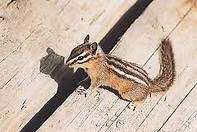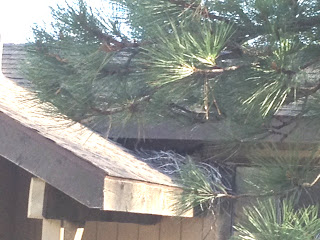Monday, April 30, 2012
Nature Red in Tooth and Claw...and Beak
Oh my. As I was watching two cute, tiny little chipmunks on my deck, it dawned on me--that's what my raving ravens were eating on top of my neighbor's barbecue. Not a mouse or a rat, but an adorable chipmunk. Oh my. But then I had to remind myself that while chipmunks are the prey of many mammals and birds, they are also predators themselves, often raiding a nest of bird's eggs or nestlings. Oh my.
Saturday, April 28, 2012
Raven Update: I hope my neighbor doesn't see this!
(If you haven't read the previous entry: My Raving Ravens are Back, read that first as this is a follow-up to that one.)
I returned from a 2 week trip to find the female raven in her nest, while the male is always very close by. There must be eggs as she stays there all the time now.
 |
| She is stretched out along the back of the nest. |
 |
| He sits in one of several trees beside the house. (Her nest is in the right corner of the photo.) |
 |
| Or he perches on a telephone pole beside the nest house. |
 |
| He let her eat first. |
 |
| Then when she flew back to the nest, he finished the leftovers. |
(Still on raven watch. To be continued....)
Friday, April 20, 2012
My Raving Ravens are Back!

Raven on the railing of my deck just outside the kitchen window.
Last year I began my blog with the delightful antics of a raven family that kept us entertained all summer. (Check out Raving about Ravens July 2011.) The youngsters have grown and flown the coupe but the Ma and Pa, who mate for life, are still here, and to my excitement (yeah, I don't get out much), they built a nest across the street under our neighbor's roof.

Not the clearest picture but you can see her curled up on the nest.

Not the clearest picture but you can see her curled up on the nest.
The two of them fly all over the neighborhood calling out to each other; they're always together or at least within cawing range. They even started hanging out on the neighbor's deck again. (It won't be long before he sets up the scary owl, I'm sure.)
But one windy, rainy weekend near the end of March, I noticed a tarp had been placed on the roof in such a way that it covered the nest. In fact, it flapped so much in the wind, making such a racket, I was certain the ravens would abandon the nest.
About a week later while walking my dog, I glanced at the nest and noticed some movement. She was still there! You can see her beak sticking out just under the roof's edge below.

She is there daily but comes and goes, so I'm not sure if there are eggs yet. Once she does lay eggs, incubation is 20-25 days and then nesting from 28-50 days. So it will be awhile before I see the new family flying about.
I plan to follow them through the season and keep you informed!
For more basic info on ravens:
http://www.allaboutbirds.org/guide/Common_raven/lifehistory
Wednesday, April 18, 2012
Found the Next Chapter in My Life: Working with Wildlife
Coyotes by my house in Lake Arrowhead
Recently I began studying the wildlife commonly found in the San Bernardino Mountains: Black bears, mountain lions, mule deer, bobcats, coyotes, foxes, and magnificent birds of prey, just to name a few. I thought that by understanding their habits and habitat, I could come to enjoy and respect their presence, as well as avoid any foolish mistakes that might endanger their lives or mine.
Having done this with horses, I learned the value of “thinking like a horse” which makes working with them easier and loving them richer. Rather than projecting human thoughts and needs and fears into their heads, I want to be aware of what brings them pleasure and comfort, what piques their curiosity, or what scares the bejesus out of them. A filmmaker may find beauty in an air-born plastic bag (American Beauty), but any horse-owner will tell you, a white bag blown about by a gentle breeze is as terrifying to a horse as a stalking mountain lion. Maybe worse for, What the hell is that thang?
In addition to reading some great books on wildlife (I’ll post a list soon), I also began training as a Wildlife Care Provider at Wildhaven Ranch a wildlife sanctuary near Lake Arrowhead, and with that new responsibility, I began visiting local zoos and talking with zookeepers and curators as well as vets. As a result, I discovered not a hobby or part time activity but a burning fascination that is clearly the next chapter in my life: Working with wildlife in captivity.
Orphaned 6 month old mountain lion at Orange County Zoo
I used to have a problem with zoos; seeing animals in captivity broke my heart. But I came to learn that most animals in zoos and sanctuaries cannot be released into the wild. Some would not survive due to injuries and disabilities, such as a hawk with a broken wing; others because they are human habituated. While rehabilitation facilities strive to rehab and release, some animals become imprinted on the humans that care for them and cannot be successfully placed back in the wild. Animals orphaned at a young age are often brought to facilities where they are hand-fed and cared for and thus become imprinted on their caretaker. Others are former “pets” of people foolish enough to think a cute little bobcat or fawn could be a part of their family. Some are former “performing” animals bred and raised for this purpose, and others are actually born in captivity.
So here they are, living their lives in a zoo or sanctuary; why not make it the best life they can have? Amazing changes have taken place since I was a little girl visiting a zoo and seeing tigers in small cages. Not only have the exhibits been improved to provide the animal with a more natural habitat, but care providers work hard to enrich the lives of their animals in other ways to keep them active, stimulated and challenged.
I am so excited about my new venture. I have met fascinating people devoted to their work, and most importantly, I've become acquainted with some amazing animals. There is nothing like looking into the eyes of a black bear or a mule deer--up close and definitely personal.
So expect to be reading everything I learn or experience as I pursue my new passion.
Mule deer at Wildhaven Ranch
Spectacled Bear at Binghamton Zoo
Subscribe to:
Posts (Atom)









